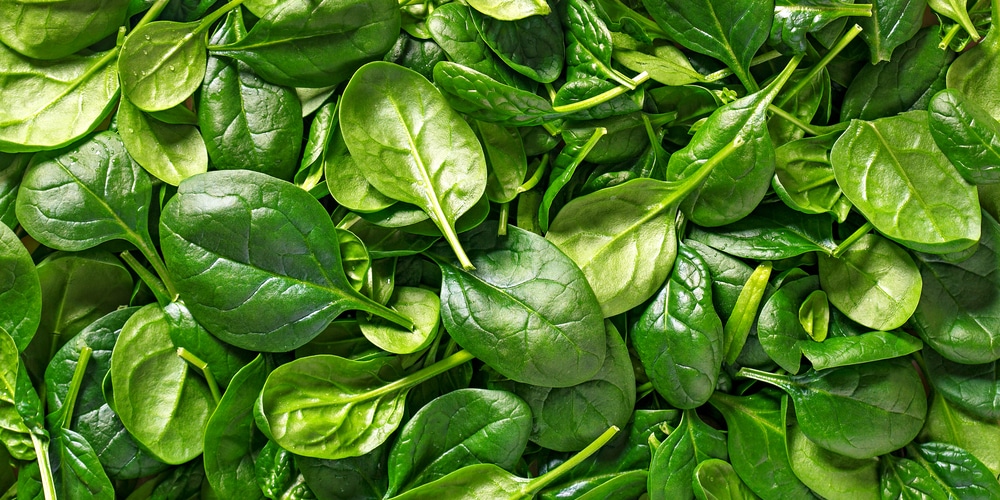Spinach is a cool-season leafy green that provides plenty of nutrition. This vegetable is rich in fibers, iron, and vitamins A, B, and C. Despite what you may think, this veggie isn’t particularly challenging to grow. Indeed, these versatile plants will perform well in full sun or partial shade.
Not many people know that spinach is native to southwest Asia. Avoid planting your leafy greens when the temperatures are too high, and ensure you keep them moist.
If you are afraid of pests, don’t hesitate using row covers: it will deter insects and contribute to maintaining your plants cool. You can also add a layer of mulch to prevent your plants from suffering thermal shock, improve drainage, increase water retention, and keep weeds at bay.
But what spinach types are out there? And how can you choose the best variety for your garden? Keep reading this essential guide if you want to learn everything you need to know on the subject!
Spinach Types
To simplify things, we can say that there are two spinach varieties. You can recognize them by looking at their leaves, which can be smooth or wrinkly.
The latter types are better known as “savoy” and are the most common varieties among gardeners growing vegetables in their yard.
They are the ones that you’ll see fresh at the supermarket. After all, they tend to have longer shelf lives and better flavors. Still, due to their bitter flavors, most people prefer them cooked.
Some varieties are a mix of the two and are known as semi-savoy. But let’s look at the characteristics of the three in more detail.
Savoy Spinach
You can recognize savoy spinach from its wrinkled leaves and low-growing tendencies. Despite the unappealing looks, these plants are the more productive types of spinach. Also, they adapt better to low temperatures, making them the ideal option if you live in the northern parts of the country.
You can use savoy spinach fresh to add a crunchy texture to your salads or sandwiches or cook it with garlic, onion, or cheese to enhance its flavors.
Within the savoy spinach category, there are several varieties. For instance, the Regiment spinach is a hybrid with thick and broad leaves. It germinates and grows fast, making it perfect if you don’t want to wait too long for your harvests.
Similarly, you can expect to harvest your Bloomsdale spinach within 45 days after planting. However, keep in mind that this variety performs better under the full sun: ensure you place it in a sunny location to get the most out of your veggies. Besides the two, you can also find hammerhead and Palco spinach: both are savoy and grow fast.
Smooth Leafed Spinach
As you can expect from its name, smooth leafed spinach doesn’t have wrinkled leaves. Also, these veggies are sweeter and more delicate than the savoy varieties, making them perfect ingredients for a fresh salad. While you can also eat these leafy greens frozen, they’ll taste much better raw.
Some varieties include space spinach, which will mature within 45 days after planting. Other options are gazelle spinach, which is very productive and better suited for the fall harvest season, and flamingo spinach, which may produce its first harvests in as little as 28 days.
Finally, you can recognize the Red Kitten spinach by the dark red veins on the plant’s surface. Due to their bolting speed (which will impact the flavor), you should harvest this spinach fast. So, don’t forget to keep an eye on your plants when the time to pick them gets closer.
Semi-Savoy Spinach
If you can’t decide between savoy and smooth-leafed, you can plant semi-savoy spinach in your garden. These greens have a crispy texture and a bitter flavor similar to savoy spinach. However, its wrinkles are not as deep, making it less challenging to clear.
Some semi-savoy spinach varieties include the tyee, which performs better when you grow it in the fall and harvest it in the spring. The Catalina is also a spinach type that will withstand light frost and won’t have problems growing in partial shade. If you struggle with powdery mildew, consider planting Teton: this spinach variety is resistant to the disease.
Plus, under the ideal conditions, it will grow fast and abundantly.
Finally, the Indian Summer Spinach is a variety that you can grow in summer, spring, and fall.
Related Article: How Much Water Does Spinach Need?


